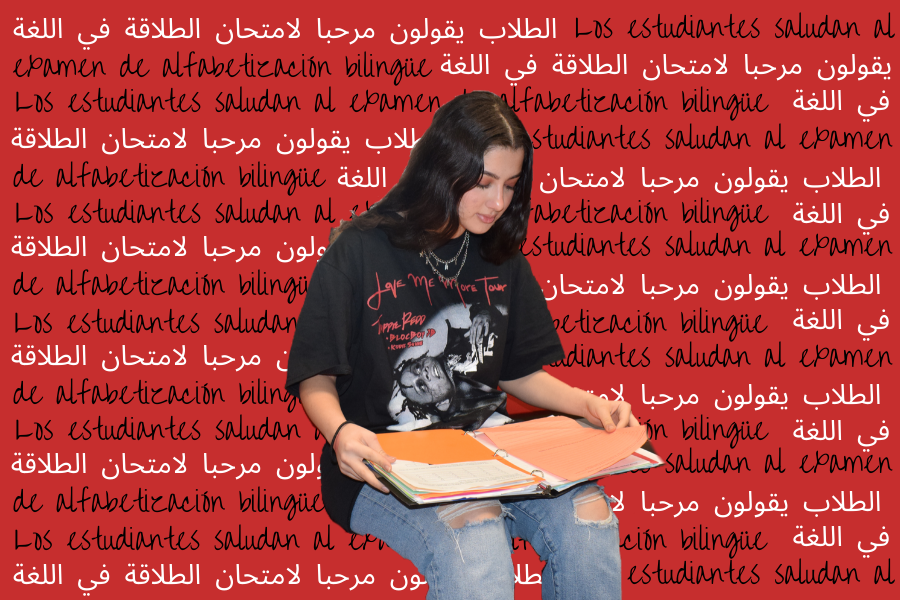By taking the biliteracy exam, students had the opportunity to achieve the Seal of Biliteracy, a seal that demonstrates achievement in both English, a language other than English (LOTE) and sociocultural awareness.┬а
Junior Ulaa Kuziez chose to take the exam for Arabic, a language she grew up speaking.┬а
тАЬ[Arabic] means a lot to me because it’s my family’s language and my country’s language, so I hold those close to me because they are part of my identity,тАЭ Kuziez said. тАЬNot only is my country part of my identity and my religion, but also the language I speak and the culture I come from and my heritage.тАЭ┬а
Arabic is one of many languages offered, along with French, German, Hebrew, Hindi, Italian, Japanese, Korean, Mandarin Chinese, Polish, Portuguese, Russian and Spanish. Junior Sara Albarcha chose to put her Spanish skills to the test after taking the class for three years.┬а
тАЬHopefully, it gives me more opportunities in college to go more into Spanish and learn more about languages and other cultures. I hope to become fluent in Spanish, more than I am now,тАЭ Albarcha said. тАЬIt’s always good to know more than one language and to know more about other cultures than just your own. I think that it helps you to be more open.тАЭ
The test consists of four parts: reading, speaking, listening and writing and takes an estimated four hours.┬а
тАЬIt felt good to practice something I loved and review something that I hadn’t done in a while. I feel happy that there is a program like this that exists, a program that tries to honor studentsтАЩ languages and their heritage, instead of only helping them assimilate to the American culture and language,тАЭ Kuziez said.┬а
Despite feeling nervous before the test, after completing the exam, Albarcha felt ready to grow in her Spanish knowledge.┬а
тАЬ[I would encourage other students to take the test] to test [their] abilities in the language that [theyтАЩre] taking because it might help you realize that you should study more in your class or help you know that you’re ready to go speak out in public in that language,тАЭ Albarcha said. тАЬI learned I should practice more, but that doesn’t matter because I can go back to Spanish class and learn.тАЭ
Spanish teacher Francisco Navarro understands the importance of learning languages and emphasizes the benefits that it can have on students.┬а
тАЬ[It is important to learn languages] so that you can communicate with many more peopleтАУdouble the number of people that you can talk with. It makes you a more open-minded person in general. You [become] less close-minded, and you are willing to learn new things,тАЭ Navarro said.
Navarro believes that earning the Seal of Biliteracy can allow students to prosper in college and in future careers.┬а
тАЬIf a student speaks more than one language, it’s nice for it to be recognized on your transcript. I think it could be something on a transcript that you have that someone else doesn’t,тАЭ Navarro said. тАЬIt could make you stand out. You can potentially let future employers know that you’re bilingual and can speak another language and can read a language other than English.тАЭ
As an immigrant, Kuziez feels that language is an important cultural element and the biliteracy exam is a way to embrace it.┬а
тАЬWe should not be ashamed of our language; rather, we should be proud of it, and we should continue to pursue it in order to hold onto our identities. When I was learning [English], I felt that I had to let go of Arabic to be fully assimilated in American society. I’ve come to realize that Arabic is part of my identity, and I’m not going to let go of that to please other people,тАЭ Kuziez said. тАЬThere is a norm in America for immigrants to completely assimilate to American culture, but that doesnтАЩt mean we need to lose a core part of our identity and an important part of our lives. ItтАЩs really important for immigrants and students from different backgrounds to continue to hold tight to their identities.”



![Gazing up from the stage, junior Joseph McCurdy who played Peter Pan in the school play, Lost Girl, sits next to senior Juliana Rogers, who plays Wendy Darling, during a theater rehearsal. McCurdyтАЩs passion for theater began when he observed a West High production in middle school. тАЬI've been in the high school theater program since I was a freshman. I've always loved theater, but [what prompted me to join] was [when] I went to see [a performance here] when I was in middle school, and it was super cool,тАЭ McCurdy said.](https://pwestpathfinder.com/wp-content/uploads/2025/11/IMG_6535-1200x798.jpeg)

![Standing tall, stacked in a precise formation, the cheer team strikes a signature pose during halftime on Sept. 12 at the varsity football game. Nearly a month after this performance, the cheer team performed at the Missouri Cheerleading Coaches Association (MCCA) regional competition on Oct. 4, 2025. тАЬWe've all come [to] work together a lot more,тАЭ sophomore Elyssa Philippi said. тАЬWe're a lot closer than we were [earlier in the season] and going to state has made us closer [in] trying to work with each other, learn [new] skills and make our team better.тАЭ](https://pwestpathfinder.com/wp-content/uploads/2025/11/DSC5139-1.jpg)
![Handing out candy to excited trunk-or-treaters, President of the United Nations ChildrenтАЩs Fund club and junior Sara Ashok represents that group. Ashok was eager to participate in this event for multiple reasons. тАЬI really wanted to be a part of the event because I get to help create memories for kids and spend time with my friends, spreading the things [I'm passionate about],тАЭ Ashok said.](https://pwestpathfinder.com/wp-content/uploads/2025/11/DSC_8648-1-1200x800.jpg)

![Smiling in a sea of Longhorns, Fox 2 reporter Ty Hawkins joins junior Darren Young during the morning Oct. 3 pep rally. The last time West was featured in this segment was 2011. тАЬ[I hope people see this and think] if you come to [Parkway] West, you will have the time of your life because there are so many fun activities to do that make it feel like you belong here. I was surprised so many people attended, but it was a lot of fun,тАЭ Young said.](https://pwestpathfinder.com/wp-content/uploads/2025/10/Edited2-1200x798.jpg)
![West High seniors and families listen as a representative of The Scholarship Foundation of St. Louis, Teresa Steinkamp, leads a Free Application for Federal Student Aid (FAFSA) workshop. This session, held in the library, provided guidance on financial aid, scholarships and student loan options. тАЬThis event is very beneficial for any seniors who are applying to or considering applying to colleges after high school [because] the cost of college is on the rise for seniors and parents,тАЭ college and career counselor Chris Lorenz said.](https://pwestpathfinder.com/wp-content/uploads/2025/09/DSC_4478-1200x778.jpg)
![Senior Kamori Berry walks across the field during halftime at the Homecoming football game on Sept. 12. During the pep assembly earlier that day, she was pronounced Homecoming Queen. тАЬI thought it was nice that the crowd [started] cheering right away. I know [my friends] were really excited for me, and my family was happy because typically non-white people don't win,тАЭ Berry said.](https://pwestpathfinder.com/wp-content/uploads/2025/09/DSC7046-Enhanced-NR-1200x798.jpg)




Mira Nalbandian • Feb 12, 2020 at 3:55 pm
Great story!